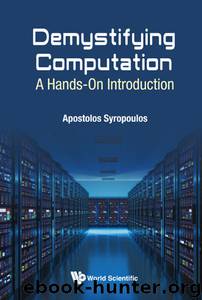Demystifying Computation:A Hands-On Introduction by Apostolos Syropoulos

Author:Apostolos Syropoulos
Language: eng
Format: azw3
ISBN: 9781786342683
Publisher: World Scientific Europe Ltd
Published: 2017-04-19T04:00:00+00:00
4.5Chaos Computing
In the Mediterranean region, snow is something one does not see everyday during winter. As a matter of fact, snowing is considered as a major event! Now, imagine what happens when the Meteorological Service predicts that in some areas, there will be some snowfall, but instead another sunny day passes by! Some people think that the Meteorological Service is kidding people, but the fact is that weather forecasting is not easy. It is known that we cannot predict how will be the weather in say 10 or 20 days from now. What is not widely known is why this happens. Moreover, it is not known if there is room for improvement.
Edward Norton Lorenz was a mathematician and meteorologist at the Massachusetts Institute of Technology. Lorenz wanted to use computers to predict the weather. He created a simple model, but soon he realized that when we slightly change the input parameters, we get completely different results. For example, he noticed that when his computer simulation was fed with decimal numbers with three decimal digits (e.g., numbers like 0.306) instead of decimal number with six decimal digits (e.g., numbers like 0.306127), the results were not the same as one would expect. Although his simulation involved 12 ordinary differential equations, one can observe the same effect using a much simpler mathematical expression. For example, one can use the quadratic expression p + rp(1 − p) with initial value p0 = 0.1 and r = 3. Next, one computes the expression p′ = 0.1 + 3 × 0.1 × (1 − 0.1) and uses p′ to recompute the expression p′ + rp′(1 − p′) and so on. If at some point, the iteration stops and p is truncated to three decimal digits and the operation resumes with this value and goes to the end without any other interruption, the result will be quite different from what we will get if no interruption happened. Table 4.1 shows two iterations: one where an interruption is accompanied by a truncation of the output and one where nothing happens and the process finishes normally. Lorenz published his findings in 1963.27 What happens here is an effect that is known in the literature as the sensitive dependence on initial conditions effect. Lorenz is also known for another effect: the butterfly effect. This was documented in his talk at the 139th meeting of the American Association for the Advancement of Science on December 29, 1972. His talk was titled “Predictability: Does the Flap of a Butterfly’s Wings in Brazil Set Off a Tornado in Texas?” In this talk, he essentially asserted that small causes can have large effect. Because of this, he concluded that it will be impossible to answer the question posed by the title of his talk in a few years. Of course, we cannot answer this question with certainty today.
Download
This site does not store any files on its server. We only index and link to content provided by other sites. Please contact the content providers to delete copyright contents if any and email us, we'll remove relevant links or contents immediately.
Deep Learning with Python by François Chollet(12863)
Hello! Python by Anthony Briggs(10116)
The Mikado Method by Ola Ellnestam Daniel Brolund(10007)
OCA Java SE 8 Programmer I Certification Guide by Mala Gupta(9977)
Dependency Injection in .NET by Mark Seemann(9512)
Algorithms of the Intelligent Web by Haralambos Marmanis;Dmitry Babenko(8518)
Grails in Action by Glen Smith Peter Ledbrook(7878)
Test-Driven iOS Development with Swift 4 by Dominik Hauser(7848)
The Well-Grounded Java Developer by Benjamin J. Evans Martijn Verburg(7764)
Becoming a Dynamics 365 Finance and Supply Chain Solution Architect by Brent Dawson(7689)
Microservices with Go by Alexander Shuiskov(7443)
Practical Design Patterns for Java Developers by Miroslav Wengner(7370)
Test Automation Engineering Handbook by Manikandan Sambamurthy(7311)
Angular Projects - Third Edition by Aristeidis Bampakos(6732)
Secrets of the JavaScript Ninja by John Resig Bear Bibeault(6629)
The Art of Crafting User Stories by The Art of Crafting User Stories(6229)
NetSuite for Consultants - Second Edition by Peter Ries(6173)
Demystifying Cryptography with OpenSSL 3.0 by Alexei Khlebnikov(5988)
Kotlin in Action by Dmitry Jemerov(5293)
